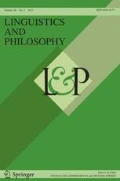Abstract
This paper contributes to the study of explicit performative utterances in the following ways. First, it presents arguments that support Austin’s view that these utterances are not assertions. In doing so, it offers an original explanation of why they cannot be true or false. Second, it puts forward a new analysis of explicit performatives as cases of showing performing, rather than of instances of asserting or declaring that one is performing a particular act. Finally, it develops a new account of the role of the performative prefix in signalling performative intentions that shows how the prefix can play a special role in the interpretation of performatives utterances.
Similar content being viewed by others
References
Alston W.P. (2000) Illocutionary acts and sentence meaning. Cornell University Press, Ithaca, NY
Austin, J. L. (1950/1979). Truth. In J. O. Urmson & G. J. Warnock (Eds.), Philosophical papers (3rd ed., pp. 117–133). Oxford: OUP. Originally published in Proceedings of the Aristotelian Society, supplementary volume XXIV
Austin J.L. (1962/1975). How to do things with words (2nd ed). Cambridge, MA, Harvard University Press
Austin, J. L. (1979). Performative utterances. In J. O. Urmson & G. J. Warnock (Eds.), Philosophical papers (3rd ed. pp. 117–133). Oxford: OUP.
Bach K. (1994) Conversational impliciture. Mind and Language 9: 124–162
Bach K. (1995) Standardization vs. conventionalization. Linguistics and Philosophy 18: 677–686
Bach K., Harnish R.M. (1979) Linguistic communication and speech acts. MIT Press, Cambridge, MA
Bach K., Harnish R.M. (1982) Katz as Katz can. The Journal of Philosophy 79(3): 168–171
Bach K., Harnish R.M. (1992) How performatives really work: A reply to Searle. Linguistics and Philosophy 15: 93–110
Barker S. (2003) Truth and conventional implicature. Mind 112(445): 1–33
Barker S. (2004) Renewing meaning. OUP, Oxford
Blakemore, D. (1990/91). Performatives and parentheticals. Proceedings of the Aristotelian Society, 91, 197–213.
Carston R. (2002) Thoughts and utterances: The pragmatics of explicit communication. Blackwell, Oxford
Corazza E. (2005) On epithets qua attributive anaphors. Journal of Linguistics 41: 1–32
Davidson, D. (1979/2001). Moods and performances. In Inquiries into truth and interpretation (2nd ed., pp. 109–121). Oxford: OUP. Originally published in Margalit, A. Meaning and use. Dordecht: Reidel.
Dummett, M. (1959/1978). Truth. In Truth and other enigmas (pp. 1–24). London: Duckworth. Originally published in Proceedings of the Aristotelian Society, n.s., vol. LIX, pp. 141–162.
Dummett, M. (1981). Frege: Philosophy of language (2nd ed.). London: Duckworth.
Dummett, M. (1993). Mood, force and convention. The seas of language. Oxford: Clarendon Press.
Fraser, B. (1975). Hedged performatives. In P. Cole & J. L. Morgan (Eds.), Syntax and semantics volume 3: Speech acts (pp.187–210). New York: Academic Press.
Frege, G. (1918–19/1997). Thought/Der Gedanke. In M. Beaney (Ed.), The Frege reader (pp. 325–345). Oxford: Blackwell. Originally published in Beiträge zur Philosophie des deutchen Idealismus I: 58–77
García-Carpintero, M. (2004). Assertion and the semantics of force-markers. In C. Bianchi (Ed.), The semantics/pragmatics distinction (pp. 133–166). Stanford: CSLI Publications.
Geach P. (1965) Assertion. The Philosophical Review 74: 449–465
Ginet C. (1979) Performativity. Linguistics and Philosophy 3: 245–265
Green, M. S. (2005, July). Cohen’s problem and dynamic semantics. Paper presented at 9th International Pragmatics Conference, Riva del Garda, Italy.
Green, M. S. (forthcoming-a). Expression, indication and showing what’s within. Philosophical Studies.
Green, M. S. (forthcoming-b). Self-expression. Oxford: OUP.
Kaplan D. (1978) On the logic of demonstratives. Journal of Philosophical Logic 8: 81–98
Korta K., Perry J. (2006) Three demonstrations and a funeral. Mind and Language 21: 137–240
Lycan W.G. (2000) Philosophy of language: A contemporary introduction. Routledge, London
McGinn C. (1977) Semantics for non-indicative sentences. Philosophical Studies 12: 301–311
Millikan R. (2005) Language: A biological model. OUP, Oxford
Pagin P. (2004) Is assertion social?. Journal of Pragmatics 36: 833–859
Perry J. (2001) Reference and reflexivity. CSLI Publications, Stanford
Recanati F. (1987) Meaning and force: The pragmatics of performative utterances. CUP, Cambridge
Recanati, F. (2004). Literal meaning. Cambridge: CUP.
Reimer M. (1995) Performative utterances: A reply to Bach & Harnish. Linguistics and Philosophy 18: 677–686
Searle J.R. (1989) How performatives work. Linguistics and Philosophy 12: 535–558
Sperber, D. (1994). Understanding verbal understanding. In J. Khalfa (Ed.), What is intelligence? (pp. 179–198). Cambridge: CUP.
Sperber D., Cara F., Girotto V. (1995) Relevance Theory explains the Selection Task. Cognition 57: 31–95
Sperber, D. & Wilson, D. (1986/1995). Relevance: Communication and cognition (2nd ed.). Oxford: Blackwell.
Stalnaker, R. C. (1978). Assertion. In P. Cole (Ed.), Syntax and semantics 9: Pragmatics (pp. 315– 332). London: Academic Press.
Stalnaker R.C. (2002) Common ground. Linguistics and Philosophy 25: 701–721
Strawson P. (1964) Intention and convention in speech acts. Philosophical Review 73(4): 439–460
Williamson T. (1996) Knowing and asserting. The Philosophical Review 105(4): 489–523
Wilson D. (1995) Is there a maxim of truthfulness?. UCL Working Papers in Linguistics 7: 197–212
Author information
Authors and Affiliations
Corresponding author
Additional information
Earlier versions of (parts of) this paper were presented at the UCL Pragmatics Reading Group in March 2006, at Roehampton University in May 2006, and at the conference on Utterance Interpretation and Cognitive Models held at the Univeristé Libre de Bruxelles in June 2006. I am grateful to audiences at these events for useful comments. People deserving particular thanks include Nicholas Allott, Robyn Carston, Manuel García-Carpintero, Sally McConnell-Ginet, and Deirdre Wilson. I also thank Kent Bach, who generously read and commented to two earlier drafts. Finally, I’m grateful to two anonymous referees for useful comments and suggestions.
Rights and permissions
About this article
Cite this article
Jary, M. Are explicit performatives assertions?. Linguist and Philos 30, 207–234 (2007). https://doi.org/10.1007/s10988-007-9015-9
Received:
Accepted:
Published:
Issue Date:
DOI: https://doi.org/10.1007/s10988-007-9015-9




